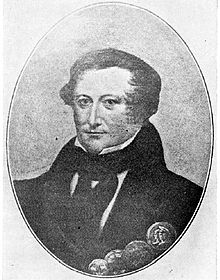| James Marsh | |
|---|---|
 James Marsh James Marsh | |
| Born | (1794-09-02)2 September 1794 Kent, England |
| Died | 21 June 1846(1846-06-21) (aged 51) |
| Occupation | Chemist |
| Spouse | Mary Marsh |
James Marsh (2 September 1794 – 21 June 1846) was a British chemist who invented the Marsh test for detecting arsenic. Born in Kent, he was working as a labourer in Woolwich in the late 1810s and early 1820s, before joining the Royal Artillery. He was married to Mary, and had four children, two of whom died in infancy. His surviving daughters were Lavinia Bithiah (1821–1896) and Lucretia Victoria (1829–1910).
Scientific work
While Marsh was most famous for inventing the test that bears his name, he was also a skilled and inventive scientist who held the post of Ordnance Chemist at the Royal Arsenal at Woolwich. He developed the screw time fuze for mortar shells and in 1830 the percussion tube. In 1832 HMS Castor was the first ship to have her guns modified with these innovations. They were not approved for the Army until 1845, when Woolwich began their manufacture—for coastal artillery only. They became obsolete in 1866. Marsh also worked as an assistant to Michael Faraday at the nearby Royal Military Academy from 1829 to 1846.
Marsh invented the earliest form of vibrating electrical interrupter in 1824. It consisted of a straight wire electrically connected and flexibly suspended at the top while the lower end extending into a shallow mercury filled trough which served as a second electrical contact. The lower end of the wire was also positioned between the poles of a powerful permanent horseshoe-shaped magnet. When electric current flowed through the wire, the magnetic field of the wire created a force with the field of the permanent magnet such that the wire would rotate out of the mercury trough and interrupt the electrical circuit. Without the magnetic force, the wire would then fall back due to the force of gravity into the mercury thereby restoring the connection and restarting the cycle of vibration.
In 1833 Marsh was called as a chemist by the prosecution in a murder trial, wherein a certain John Bodle was accused of poisoning his grandfather with arsenic-laced coffee. Marsh performed the standard test by mixing a suspected sample with hydrogen sulfide and hydrochloric acid. While he was able to detect arsenic as yellow arsenic trisulfide, when it came to showing it to the jury it had deteriorated, allowing the suspect to be acquitted due to reasonable doubt. Annoyed by this, Marsh developed a much better test. He combined a sample containing arsenic with sulfuric acid and arsenic-free zinc, resulting in arsine gas. The gas was ignited, and it decomposed to pure metallic arsenic which, when passed to a cold surface, would appear as a silvery-black deposit. So sensitive was the test that it could detect as little as one-fiftieth of a milligram of arsenic. He first described this test in The Edinburgh Philosophical Journal in 1836.


References
- The baptism registers for his daughters Eleanor Waters Marsh (17 August 1817) and Lavinia Bithiah (9 September 1821) at St Mary Magdalene Church, Woolwich, both record James as a labourer, living at Rush Grove Place in Woolwich. The baptism of his son James Frederic Marsh (2 October 1825), again at St Mary Magdalene Church, states that he is a sergeant in the Royal Artillery.
- His eldest daughter, Eleanor Waters Marsh, was buried at St Mary Magdalene Church, Woolwich, on 28 September 1817. The burial register records her age as 11 months. James Frederic Marsh was buried at St Mary Magdalene Church, Woolwich, on 17 September 1826. He was born on 24 August 1825, so would have been 12 months old when he died (Baptism registers for St Mary Magdalene Church, Woolwich, on Ancestry.co.uk)
- Baptism registers for St Mary Magdalene Church, Woolwich, on Ancestry.co.uk; FreeBMD register entries for Lavinia B Hatton and Lucretia V Cram
- Jacob Green (1827). Electro-magnetism: being an arrangement of the principal facts hitherto. p. 66.
- Marsh J. (1836). "Account of a method of separating small quantities of arsenic from substances with which it may be mixed". Edinburgh New Philosophical Journal. 21: 229–236.
- McMuigan, Hugh (1921). An Introduction to Chemical Pharmacology. Philadelphia: P. Blakiston's Son & Co. pp. 396–397. Retrieved 16 December 2007.
- Roget, Peter (1832). Treatises on Electricity, Galvanism, Magnetism, and Electro-Magnetism.
Further reading
- The Inheritor's Powder: a cautionary tale of poison, betrayal and greed by Sandra Hempel (London, 2013). BBC Radio 4 Book of the Week
- Marsh J. (1836). "Account of a method of separating small quantities of arsenic from substances with which it may be mixed". Edinburgh New Philosophical Journal. 21: 229–236.
- McMuigan, Hugh (1921). An Introduction to Chemical Pharmacology. Philadelphia: P. Blakiston's Son & Co. pp. 396–397. Retrieved 16 December 2007.
- Wanklyn, James Alfred (1901). Arsenic. London: Kegan Paul, Trench, Trübner & Co. Ltd. pp. 39–57. Retrieved 16 December 2007.
james marsh test.
- Webster, Stewart H. (1947). "The Development of the Marsh Test for Arsenic". Journal of Chemical Education. 24 (10): 487–490. Bibcode:1947JChEd..24..487W. doi:10.1021/ed024p487.